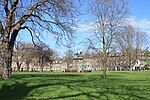West Register House is a building of the National Records of Scotland, located on Charlotte Square in Edinburgh, Scotland, United Kingdom. The building was constructed between 1811 and 1814 as St George's Church and converted to its current purpose as a records office between 1964 and 1970.
The church's site in the centre of the western side of Charlotte Square had been designated for a church as part of James Craig's initial plan for the New Town. The building was designed by Robert Reid after a similar but more intricate plan by Robert Adam, who designed the square's surrounding terraces. Construction began in 1811 and, though initially projected to cost £18,000, the total cost came to £33,000. The facade centres on an Ionic portico, above which rises a substantial green copper dome on a tall, peristyle drum. The dome, topped by a gilt cupola and cross, is a prominent feature of the Edinburgh skyline and terminates the view west along George Street. The interior of the church was gutted during its conversion as a records office. It had been noted for its tall pulpit by William Trotter.
St George's Church opened in 1814 to serve as the Church of Scotland parish church for the western half of the New Town. In its early years, it was notable for the ministries of two leading evangelicals: Andrew Mitchell Thomson and Robert Smith Candlish. The latter led out a significant portion of the congregation during the Disruption of 1843. Thomson also established a strong musical tradition at St George's: this continued with prominent choirmasters and organists, including Alexander Mackenzie. By the early 1960s, severe structural damage in the church building had become apparent and, in 1964, the congregation united with that of St Andrew's on George Street to form St Andrew's and St George's. Between 1964 and 1970, Robert Saddler converted the building for use as a public records office. A restoration of the building was completed in 2021.











